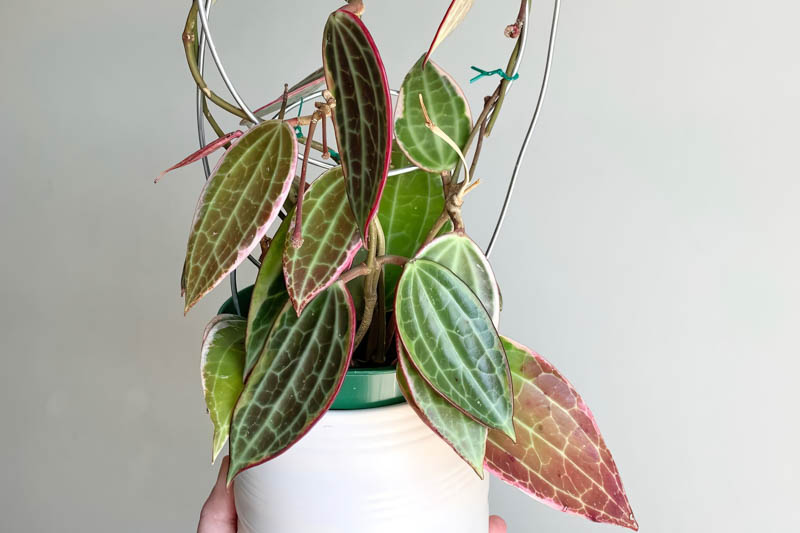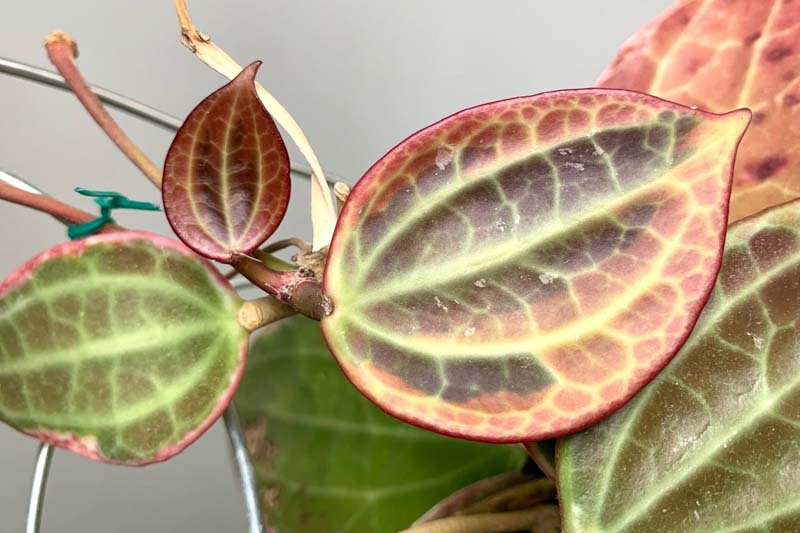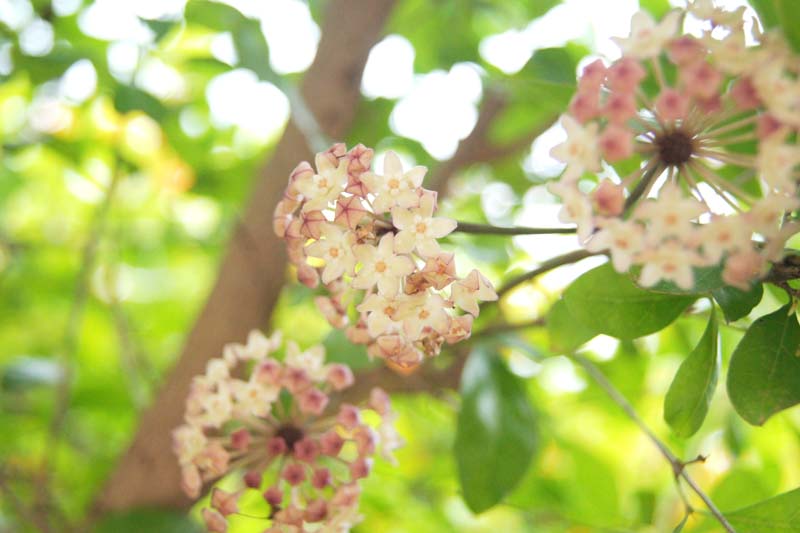Wax Plant, Honey Plant
Hoya macrophylla, a striking species within the Hoya genus, is a favorite among houseplant enthusiasts for its ornamental appeal and ease of care.
Hoya macrophylla is distinguished by its large, variegated leaves with creamy white or pink margins, creating a stunning visual contrast against the deep green centers. This vining plant produces clusters of fragrant, star-shaped flowers, adding beauty and a sweet aroma to any indoor space. Perfect for hanging baskets or trellises, it thrives in bright, indirect light.
Native: This plant is native to Vietnam, Borneo, Jawa, and the Lesser Sunda Islands. It grows as an epiphyte in tropical forests, indicating its preference for warm and humid conditions. Hoya belongs to the dogbane family (Apocynaceae), along with plumeria, periwinkle, mandevilla, or oleander.
Plant Type and Habit: Hoya macrophylla is an evergreen climbing or trailing vine that can be encouraged to grow upwards with support or allowed to cascade beautifully from hanging baskets.
Size: When grown indoors, Hoya macrophylla can reach 6 feet (180 cm) in height. Its growth rate and ultimate size will depend on the growing conditions and the care provided.
Hoya Flower: The plant produces clusters of star-shaped, sweetly fragrant flowers. The blooms are typically pink or white with a central, darker pink corona. The flowering season for Hoya macrophylla typically occurs in the warmer months, though it can bloom sporadically throughout the year under ideal conditions.
Fruit: After successful pollination, it can produce small seed pods, though this is a rare occurrence in an indoor setting.
Foliage: Hoya macrophylla boasts large, variegated leaves that stand out in any collection. Each leaf, reaching lengths of up to 6 inches (15 cm), displays a mesmerizing pattern of creamy white or yellow margins framing a deep green center, with some variations featuring pink hues. The waxy, ovate leaves are not only visually striking but also contribute to the plant’s robust, tropical appearance.
Hardiness: It is best suited for warm, indoor environments but can be grown outdoors in USDA hardiness zones 10-11.
Uses: Hoya macrophylla is primarily grown as an ornamental indoor plant, valued for its stunning foliage and fragrant flowers. It’s a popular choice for adding a touch of the tropics to interior spaces.
Toxicity: Hoya macrophylla is non-toxic to pets and humans, making it a safe addition to households with animals and children.
Invasiveness: It is not considered invasive, as it’s mostly grown in controlled indoor or greenhouse environments.
Benefits: Besides its decorative appeal, it is believed to improve indoor air quality by filtering out airborne toxins, contributing to a healthier living environment.

Growing and caring for Hoya macrophylla involves providing conditions similar to its native tropical environment.
Light: Hoya macrophylla thrives in bright, indirect sunlight. Avoid direct sunlight, which can scorch its leaves. A north or east-facing window is ideal.
Soil: Use a well-draining potting mix, ideally one that includes peat moss, perlite, and vermiculite. This combination ensures adequate drainage and air flow to the roots.
Water: Water when the top inch of soil feels dry to the touch. These plants prefer to dry out slightly between waterings. Overwatering can lead to root rot, so ensure good drainage.
Temperature and Humidity: Keep it in a warm environment, ideally between 60-85°F (15-29°C). Avoid sudden temperature changes and keep it away from drafts. As a tropical plant, Hoya macrophylla appreciates high humidity. Aim for 60-80%. You can increase humidity with a humidifier, pebble tray, or by misting the plant regularly.
Fertilization: Feed with a balanced, water-soluble fertilizer every 4-6 weeks during the growing season (spring through summer). Reduce feeding in the fall and winter.
Pruning: Pruning is not necessary for health but can be used to shape the plant or control its size. Always prune just above a node or leaf junction to encourage new growth.
Repotting: Repot every 2-3 years or when the plant becomes root-bound. Use a slightly larger pot each time to encourage growth.

Propagating Hoya pmacrophylla is a rewarding way to expand your collection or share this beautiful plant with others. Here’s how to propagate Hoya macrophylla through stem cuttings, a simple and effective method:
Choose a Healthy Stem: Look for a healthy, vigorous stem on your Hoya macrophylla that has at least 2-3 nodes (the points where leaves attach to the stem). Healthy stems are more likely to root successfully.
Cut the Stem: Using your clean, sharp scissors or pruning shears, cut the selected stem, ensuring each cutting is about 4-6 inches long. Make the cut just below a node.
Prepare the Cutting: Remove the leaves from the bottom node or two to prevent them from rotting when planted. This also exposes the nodes, where roots will form.
Apply Rooting Hormone (Optional): Dip the cut end of the stem into rooting hormone. This step is optional but can help encourage root development.
Plant the Cutting: Fill your small pot with the well-draining potting mix and make a hole in the center. Insert the cut end of the stem into the hole, ensuring at least one node (preferably two) is buried in the soil. Gently firm the soil around the stem.
Create Humidity: To create a humid environment around the cutting, you can cover the pot with a clear plastic bag or place it under a propagation dome. Make sure the leaves do not touch the plastic, as this could encourage rot.
Place in Bright, Indirect Light: Position the pot in a location that receives bright, indirect sunlight. Avoid direct sun exposure, which can be too intense for the cutting.
Wait for Roots to Develop: Keep the soil lightly moist but not waterlogged. Roots typically begin to form within a few weeks to a few months. You can gently tug on the cutting to feel for resistance, indicating root growth.
Care for Your New Plant: Once the cutting has established a robust root system, you can care for it as you would a mature Hoya macrophylla. Continue providing bright, indirect light, moderate watering, and occasional fertilization during the growing season.

Hoya macrophylla is generally resilient, but like all plants, it may encounter pests and diseases.
Mealybugs: Look for white, cottony masses on stems and undersides of leaves. Remove with alcohol-dipped cotton swabs or apply insecticidal soap.
Scale insects: Hard, dome-shaped pests that attach firmly to stems and leaves, feeding on sap. Their presence can lead to yellowing leaves, stunted growth, and a decline in plant health.
Aphids: These small, green pests suck sap from new growth. Rinse them off with water or treat the plant with neem oil.
Whiteflies: They are tiny, winged insects that feed on plant sap, causing yellowing and weakening of leaves. Combat them by rinsing plants with water, using yellow sticky traps to catch adults, or applying insecticidal soap or neem oil to affected areas.
Root rot: Caused by overwatering and poor drainage. Ensure well-draining soil and allow the topsoil to dry out between waterings.
Gray mold or Botrytis: A gray mold that can affect leaves and stems, particularly in cool, damp conditions. Improve air circulation and reduce humidity.
Leaf Yellowing: Can be due to overwatering, underwatering, or nutrient deficiency. Adjust watering habits and consider a balanced, water-soluble fertilizer during the growing season.
Leaf Drop: Sudden temperature changes or drafts can cause leaf drop. Keep the plant in a stable environment.
Lack of Flowering: Insufficient light is the most common cause. Ensure your Hoya macrophylla receives bright, indirect light to encourage blooming.
Hoya macrophylla, known for its striking variegated leaves, is not considered extremely rare, but certain varieties, especially those with more unique variegation patterns, may be less commonly found and sought after by collectors, giving them a somewhat rare status among plant enthusiasts.
Yes, Hoya macrophylla blooms. It produces clusters of star-shaped flowers that are not only beautiful but also fragrant, typically appearing in the warmer months when the plant is grown in optimal conditions. The blooms are often pink or white, adding to the plant’s ornamental appeal.
| Hardiness |
10 - 11 |
|---|---|
| Plant Type | Houseplants, Climbers |
| Plant Family | Apocynaceae |
| Genus | Hoya |
| Exposure | Partial Sun |
| Season of Interest |
Spring (Early, Mid, Late) Summer (Early, Mid, Late) Fall Winter |
| Height |
4' - 6' (120cm - 180cm) |
| Maintenance | Low |
| Water Needs | Average |
| Soil Type | Loam, Sand |
| Soil pH | Acid, Alkaline, Neutral |
| Soil Drainage | Well-Drained |
| Characteristics | Showy, Evergreen |
| Garden Uses | Hanging Baskets, Patio And Containers |
| Garden Styles | Mediterranean Garden |
| Hardiness |
10 - 11 |
|---|---|
| Plant Type | Houseplants, Climbers |
| Plant Family | Apocynaceae |
| Genus | Hoya |
| Exposure | Partial Sun |
| Season of Interest |
Spring (Early, Mid, Late) Summer (Early, Mid, Late) Fall Winter |
| Height |
4' - 6' (120cm - 180cm) |
| Maintenance | Low |
| Water Needs | Average |
| Soil Type | Loam, Sand |
| Soil pH | Acid, Alkaline, Neutral |
| Soil Drainage | Well-Drained |
| Characteristics | Showy, Evergreen |
| Garden Uses | Hanging Baskets, Patio And Containers |
| Garden Styles | Mediterranean Garden |
How many Hoya macrophylla (Wax Plant) do I need for my garden?
| Plant | Quantity | |
|---|---|---|
| Hoya macrophylla (Wax Plant) | N/A | Buy Plants |
Create a membership account to save your garden designs and to view them on any device.
Becoming a contributing member of Gardenia is easy and can be done in just a few minutes. If you provide us with your name, email address and the payment of a modest $25 annual membership fee, you will become a full member, enabling you to design and save up to 25 of your garden design ideas.
Join now and start creating your dream garden!
Create a membership account to save your garden designs and to view them on any device.
Becoming a contributing member of Gardenia is easy and can be done in just a few minutes. If you provide us with your name, email address and the payment of a modest $25 annual membership fee, you will become a full member, enabling you to design and save up to 25 of your garden design ideas.
Join now and start creating your dream garden!